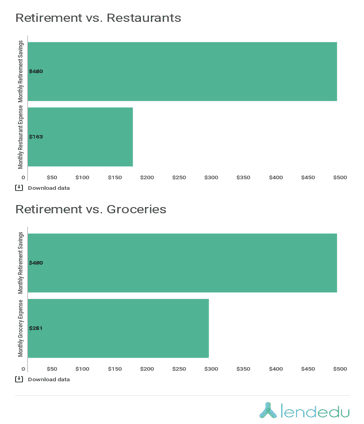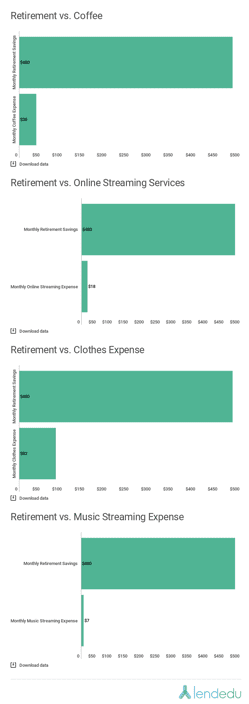How do Millennials spend their money?
When it comes to finances, Millennials tend to get a bad rap. They have a reputation for spending on consumer goods like gourmet beer and avocado toast and paying little attention to retirement plans. But are these stereotypes factual?
LendEDU surveyed 1,000 Millennials age 22 to 37 to find out exactly how this particular group of Americans spend their money, or perhaps more importantly, where they don’t.
The results show that 63% of Millennials are in fact saving for retirement, with the average amount being $480 per month. The bad news is that 37% of this demographic haven’t made any monthly payment toward their golden years.
Here, according to LendEDU’s survey results, are the most common 2018 Millennial expenses:
Millennials Love to Eat Out
When it comes to eating out, 94% of Millennials say they spend on restaurants at least monthly. In fact, only 6% of respondents said they don’t spend money on restaurants or dining over the course of the month.
On average, the survey results showed that Millennials spend $163 on restaurants or another dining-out option, with 49% spending more on restaurants than they do on saving for retirement. Those who like an adult beverage, be it while dining out or staying in (68%), are adding another $75 to their monthly tab.
Millennials spend, on average, $281 per month on groceries – but it’s clear that Millennials place a significant value on eating out.

Other Popular Millennial Expenditures
Restaurants aren’t the only place Millennials are spending money, here are the other products and services preferred by Millennial consumers:
Coffee
Millennials spend about $38 per month, or just over $450 a year, on coffee and 27% are spending more on their coffee than on their retirement. Though a full 27% of Millennials are not spending any money on coffee, perhaps preferring tea or home-brews.
Streaming Services
For Millennials, streaming services like Netflix are typically the entertainment medium of choice. Fortunately, cutting the cord – a common practice amongst this generation in which consumers drop their cable subscriptions – is often a financially sound decision. Millennials are spending just under $20 a month on Netflix or other streaming services. Music streaming services like Spotify typically cost about $7 a month.
Clothing
What Millennials save on in-home entertainment, they are spending on their wardrobe. Millennials spend an average of $82 on new clothes per month, and 32% spend more on clothes than they do on their retirement savings.

Marketing to Millennials: Key Considerations
LendEDU’s Millennial Consumer Trends data can be useful to marketers who want to target this key demographic, the largest living generation in the world. Here are some ways today’s companies can connect with millennials and cater to their consumer demands:
Provide Convenience
From streaming video and music services to dining out, Millennials, who are busy balancing both personal and professional growth, seek out products and shopping experiences that make their life easier.
For marketers, that means really focusing on the problem/solution aspect of a product or service as it relates to this market. It also means tightening up the UX, making sure your website is mobile friendly, offering various digital payment methods in store and online, etc.
In other words, convenience is king when it comes to the Millennial generation.
In a study completed by Nielsen, Millennials were found to be three times more likely than Baby Boomers to purchase basic home goods online instead of at a physical location. Further to this, Millennials were four times more likely to use Facebook and Instagram to discover new products, while 50% of the generation indicated that they find new products outside of a brick-and-mortar store.
Be Authentic
Millennials perhaps more than any other generation have a limited threshold for shallow or shameless promotional ploys. Much like they value the potential of their present and future, as indicated by their retirement saving patterns, they also value companies that take an honest and conscientious approach to both.
“Sustainability,” “honesty,” “locally,” “responsibility,” etc. are terms that translate to authenticity, and Millennials are more likely to build long-term relationships with companies that strive to or highlight their efforts to incorporate those concepts into their products and services.
One study found that 84% of millennials do not like traditional advertising nor do they trust it. Laura Friedman, Head of Global Social Business Enablement at Adobe, expounded on this: “They don’t like the pushy, disingenuous nature of commercials and will do anything within their power to skip, fast forward and even block any content that even hints at advertising.”
Friedman went on to cite Chipotle’s advertising model as one that can carry weight with Millennials. Not only does the food-chain place an emphasis on fresh, fast ingredients, but they advertise in a way that relates to Millennials.
By creating a fictional, millennial-aged character that is a sustainable farmer and fights large food companies, Chipotle created an image that resonated with the Millennial generation.
Go Social
Though not directly indicated in our study, it’s no secret that Millennials frequently engage with social networks, though which one often depends on where they fall in the Millennial time line (e.g., older Millennials are more likely to use Facebook than their younger brethren, who are fans of SnapChat).
Regardless, companies that really want to reach out to Millennials are ones that foster a thriving online presence. Cultivate an online community that highlights shared values and you’ll see brand awareness and long-term engagement grow.
Backing up this point, a study by Horowitz Research found that Millennials were the only generation that did not see television ads as the most effective advertising medium, but rather an active social media presence.
Some 63% of Millennials found that the latter is the most successful advertising technique. On the opposite end, 54% of those between the ages of 35 and 49 thought television ads were the way to go, while 44% of consumers over 50 also believed television advertising was the most impactful advertising medium.
Show Value
Though some may think that Millennials are blowing their paychecks on frivolities, that’s far from the truth. Millennials are frugal and marketers that keep that in mind are the ones that will break through the consumer barriers that often separate them from this generation.
Showing the value of a specific product or service, be it strictly financial or socially/environmentally conscious, is more likely to be useful than a standalone promotion when it comes to increasing conversion rates.
Of course, that’s not to say that pricing doesn’t matter. This group is programmed to check reviews and shop around in search of the product and retailer that fits their values. They’re going to make you work for it.
Citing that same Horowitz Research study, Millennials saw product reviews and unpacking videos as the next most impactful form of advertising behind only an active social media presence; 56% of respondents that were Millennials answered in this fashion.
Final thoughts
In conclusion, Millennials may seem like a tricky generation to navigate, and ultimately, convert into customers. However, by adapting and evolving marketing strategies to more appropriately suit the millennial generation, the possibilities are endless.
And yes, it is worth it to prioritize Millennials more so than any other demographic. Not only are they the largest living generation, but many are approaching a period of high-salaried jobs so when both the money and the numbers are there, go for it!
In his role as a Research Analyst at LendEDU, Mike uses data, usually from surveys and publicly-available resources, to identify emerging personal finance trends and tell unique stories. Mike’s work, featured in major outlets like The Wall Street Journal and The Washington Post, provides consumers with a personal finance measuring stick and can help them make informed financial decisions. In his spare time, Mike enjoys attending the biggest horse racing events of the year and hanging out with his dog, Bosco.
